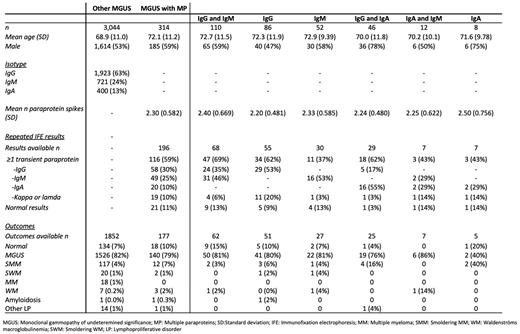Abstract
Introduction: Monoclonal gammopathy of undetermined significance (MGUS) is the precursor of multiple myeloma (MM) and related disorders. It is characterized by asymptomatic presence of monoclonal immunoglobulins (paraproteins) on serum protein electrophoresis (SPEP) and immunofixation electrophoresis (IFE). Previous smaller studies have found that in approximately 3% of MGUS cases, more than one paraprotein is observed. The isotype patterns, clinical implications, and underlying biology of these multiple paraproteins (MP) are poorly understood. To our knowledge, we have performed the first large, prospective study of MGUS cases with multiple paraproteins.
Methods: Data were acquired from the ongoing iStopMM study, a population-based screening study for MGUS and randomized trial of follow-up strategies. A total of 75,422 Icelanders over 40 years old were screened for MGUS by SPEP and IFE. Two-thirds of those with MGUS were randomized to further evaluation and follow-up.
Participants with a paraprotein on SPEP and IFE were included in the study. Those with previous MM or related disease, paraprotein ≥3.0 g/dL, or an involved to uninvolved free light chain (FLC) ratio ≥100 were excluded. Those who had more than one monoclonal peak on IFE at baseline were defined as having MP. Baseline characteristics of those with MP and a single paraprotein were then compared. In participants who were followed at the study clinic, rates of progression to MM, smoldering MM (SMM), Waldenström macroglobulinemia (WM) and other related disorders were compared using logistic regression, adjusting for age.
Available next generation flow cytometry (NGF) analyses of bone marrow in those with MP (MM-MRD panel) were reviewed.
Results: A total of 3,358 individuals with at least one paraprotein were included in the study, of whom 314 (9.4%) had MP. Persons with MP were slightly older (72.1 vs 68.9 years p<0.001) and more likely to be male (59% vs 53% p=0.01). Of those with MP, 75% had two paraproteins. The most common paraproteins were IgG (47% of spikes) and IgM (36% of spikes). IgA and kappa or lambda spikes without a heavy chain were less common (11% and 6% of spikes) (Table). Having an IgM paraprotein was associated with a higher number of paraproteins (mean: 2.4 vs 2.2 p=0.03).
After a median follow-up of 4.0 (range: 1.3-5.4) years, 59% of those with MP never had MP detected again and 42% of paraproteins were not observed again. Of the IgG, IgM, and IgA paraproteins detected at baseline, 36%, 40%, and 46% were not detected during follow-up and 81% of kappa or lambda bands were not observed again. The rate of later having a normal IFE was similar in those with and without MP (10% vs 7%; odds ratio (OR) 1.53, 95% confidence interval (CI) 0.88-2.52, p=0.11).
There was no difference in the proportion diagnosed with SMM, SWM, or WM. None with MP at baseline progressed to MM, compared with 1% (n=18) of those with a single paraprotein (Table).
NGF was available for 19 participants with MP, of whom 10 had SMM and 9 had MGUS. Two phenotypically distinct abnormal plasma cell populations were observed in 3 cases, a single phenotypically abnormal population was found in 13 (68%), and in 3 MGUS cases, no abnormal plasma cell population was detected.
Discussion: In this large, population-based screening study with 75,422 participants, we found MP to be more common in MGUS (9.4%) than previously observed, and to be associated with older age and male sex. IgM paraproteins were more common in those with MP and were associated with a higher number of paraproteins. Over half of those with MP were later found to a have a single paraprotein, and 42% of paraproteins were not observed again during follow-up. During a median of 4 years of follow-up, none with MP developed MM. We speculate that MP could in some cases be caused by a strong or defective but transient immune response and could be associated with lower risk of MGUS progression. Interestingly, we observed multiple abnormal monoclonal plasma cell populations in some with MP, but whether they develop from the same insult or independently is not clear.
With the advent of mass spectrometry-based diagnostics the rate of MP is expected to increase significantly. Understanding their clinical implications and biology will therefore become more important in guiding clinical practice. Mass spectrometry results for this cohort are pending and will shed more light on the prevalence, implications, and underlying biology of MP in MGUS.
Disclosures
Onundarson:Pall T. Onundarson MD: Patents & Royalties: patent for a new coagulation test, the Fiix prothrombin time. Hultcrantz:Bristol-Myers Squibb: Membership on an entity's Board of Directors or advisory committees; Intellisphere LLC: Consultancy; Amgen, Daichii Sankyo, Cosette, GSK: Research Funding; GSK: Consultancy, Membership on an entity's Board of Directors or advisory committees, Research Funding; Curio Science LLC: Consultancy. Durie:Takeda: Consultancy, Honoraria; Celgene/BMS: Consultancy, Honoraria; Amgen: Consultancy, Honoraria; Janssen: Consultancy, Honoraria. Harding:The Binding Site: Current Employment, Membership on an entity's Board of Directors or advisory committees. Landgren:Merck & Co., Inc.: Other: Independent Data Monitoring Committee (IDMC) member for clinical trials; Janssen: Honoraria, Other: Independent Data Monitoring Committee (IDMC) member for clinical trials, Research Funding; Rising Tide Foundation: Research Funding; Leukemia & Lymphoma Society: Research Funding; MMRF: Honoraria; Aptitude Health: Honoraria; Pfizer Inc: Consultancy; Tow Foundation: Research Funding; Riney Foundation: Research Funding; NCI/NIH: Research Funding; Theradex: Other: Independent Data Monitoring Committee (IDMC) member for clinical trials; Amgen: Honoraria, Research Funding. Kristinsson:Celgene: Research Funding; Amgen: Research Funding.
Author notes
Asterisk with author names denotes non-ASH members.


This feature is available to Subscribers Only
Sign In or Create an Account Close Modal